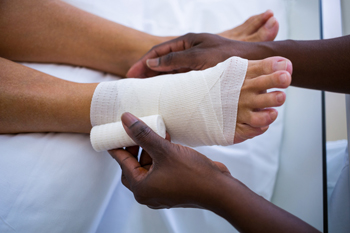
Cuts and abrasions on the lower limbs are common injuries that may seem minor but can become serious, if not treated correctly. The skin on the legs and feet is often exposed and may heal more slowly due to reduced circulation, especially in individuals with diabetes or vascular conditions. Even small wounds can turn into chronic problems, if neglected. Proper care begins with gentle cleansing to remove dirt and bacteria, followed by applying a clean dressing to protect the area. Monitoring for signs of infection, such as redness, swelling, or discharge, is essential. Wearing supportive footwear and avoiding friction helps prevent worsening of abrasions. Because lower limb wounds can be complicated by underlying health issues, it is suggested that you see a wound care specialist for a professional evaluation and the most effective treatment plan.
Wounds on the feet, ankles, and legs require special attention because these areas are extremely vulnerable to infection and slower healing. Even a small scrape or cut can become more serious if not treated promptly, particularly for individuals with diabetes, poor circulation, or weakened immune systems.
Abrasions occur when the skin is rubbed or scraped against a rough surface, often leaving raw, painful patches that expose delicate tissue. On the feet and legs, these are more susceptible to contamination from shoes, socks, and daily activities. Cuts and scrapes that break through deeper layers of the skin create open wounds that may bleed and require proper cleaning and covering to reduce risk of infection.
Some injuries are more complex. Traumatic wounds, such as lacerations caused by accidents or falls, can damage not only the skin but also the underlying structures of the foot or ankle. Puncture wounds from sharp objects are another concern, as they are often narrow and deep, allowing bacteria to become trapped inside. These injuries may not look severe on the surface, but can result in serious infection if not evaluated by a wound specialist.
Because the lower extremities play such a vital role in mobility, untreated wounds in this region can interfere with daily activities, and, in severe cases, threaten long-term health. Proper wound care includes cleaning, dressing, and monitoring the injury, and in some cases, advanced treatment to close or debride the wound and support faster healing.
If you have a cut, abrasion, or puncture wound on your foot, ankle, or leg that is not improving or appears infected, call us for help today. Prompt treatment ensures effective healing and helps protect your mobility and overall health.
